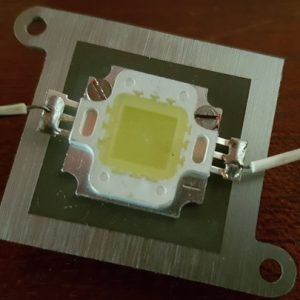LED Lamp Behaviour

LEDlamp
So I got my hands on some of these 12 volt LED lamps (chips / modules / lights / whatever) and since I had enough to burn one or two “by accident” I thought I should spend a few minutes to get to know them better.
I’m not referring to your regular little round 1.2 volt LEDs that we use by the millions for indicators and things on our projects, but instead the square, yellow modules around 25mm per side that makes white light for floodlights and so on.
So before you pull out your 12 volt battery and blow up some lights, here is an important message: LEDs are current devices, they do not like constant voltages and will promptly reward you with a puff of smoke if you persist, much like the inkfish did in the sea when it tried to escape. You have been warned. Use a constant current to feed them and everyone will be happy.
The other thing I completely underestimated is the amount of heat dissipated. They come without any protection whatsoever and your first job is to stick them to a heat sink. The 10 watt units I have require a heat sink not unlike the ones found in old computers.
Once I had my head wrapped around this weird change from incandescent lamps, I had a lot of fun playing with my packet of LEDs. They produce good white light at reasonable powers, so even if you drop the current through a small resistor from a 12v car battery they will still work.
However, there is one worrysome feature that I noticed. Assuming that each little LED is dropping around 2.98 volt (a not unreasonable number according to https://www.ledsupply.com/blog/wiring-leds-correctly-series-parallel-circuits-explained/) then you will end up with a matrix like this:

LEDmatrix
or like this:
| A | B | C |
| D | E | F |
| G | H | I |
This is not the end of the world, except that if the LEDs are not closely matched they will draw different currents, with the weakest link obviously blowing first. I expect this will manifest as one LED lighting up slightly more than another in the chain.
This is exactly what EDN found on their site at
https://www.edn.com/design/led/4325905/Driving-high-power-LEDs-in-series-parallel-arrays

I’ve made a short YouTube video to illustrate my concerns https://youtu.be/nf1654eiy1A
Watch how the LED in position “C” lights up first and then goes on to illuminate brighter and brighter. It may be the one that burns out first, or overheats the most.
What do you think, am I right or am I wrong?